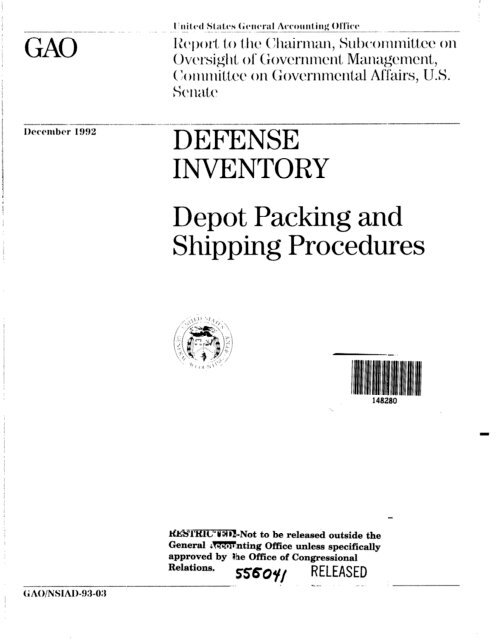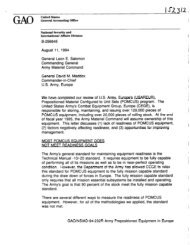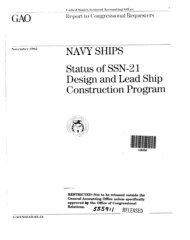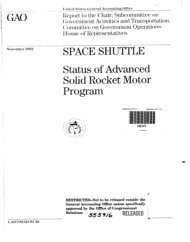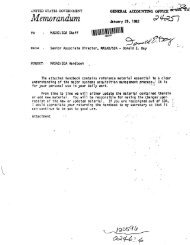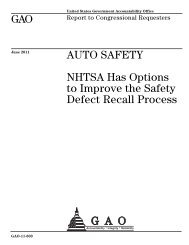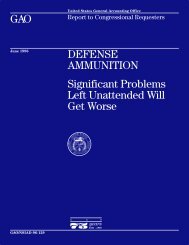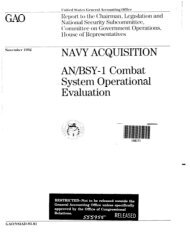Depot Packing and Shipping Procedures
Depot Packing and Shipping Procedures
Depot Packing and Shipping Procedures
You also want an ePaper? Increase the reach of your titles
YUMPU automatically turns print PDFs into web optimized ePapers that Google loves.
INVENTORY<br />
<strong>Depot</strong> <strong>Packing</strong> <strong>and</strong><br />
<strong>Shipping</strong> Procedu.res<br />
llllllllIllllll<br />
148280<br />
.---<br />
(;AO/NSIAI)-!):~-O:r<br />
&h%i”wm-Not to be released outside the<br />
General :WWkting Office unless specifically<br />
approved by Jhe Office of Congressional<br />
Relations.<br />
sssolfl<br />
RELEASED<br />
./,,,,,
GAO<br />
United States<br />
General Accounting Office<br />
Washington, D.C. 20548<br />
National Security <strong>and</strong><br />
International Affairs Division<br />
B-250085<br />
December 7,1992<br />
The Honorable Carl Levin<br />
Chairman, Subcommittee on<br />
Oversight of Government Management<br />
Committee on Governmental Affairs<br />
United States Senate<br />
Dear Mr. Chairman:<br />
As you requested, we examined the Department of Defense’s (DOD)<br />
packaging <strong>and</strong> packing practices. Specifically, you asked us to determine<br />
whether (1) Defense Logistics Agency (DIA) depots were avoiding<br />
unnecessary costs by consolidating packing of shipments going to the<br />
same military installation at the same time, (2) depots were packing <strong>and</strong><br />
shipping supply items in the most efficient <strong>and</strong> cost-effective manner, <strong>and</strong><br />
(3) military services were placing different emphasis on recycling<br />
discarded shipping materials. In conducting our analysis, we concentrated<br />
on small, consumable items managed <strong>and</strong> stored by DLA <strong>and</strong> used by the<br />
military services.<br />
Results in Brief<br />
DLA routinely consolidates the packing of low priority shipments going to<br />
the same location at the same time. However, DOD regulations do not<br />
permit the consolidation of the highest priority orders going to the same<br />
location at the same time, even though consolidation would likely result in<br />
considerable cost savings. One DLA depot has estimated that it could save<br />
approximately $250,000 annually through consolidated packing of these<br />
priority orders.<br />
DLG depots generally pack <strong>and</strong> ship supply items in an efficient <strong>and</strong><br />
effective manner. Although the Navy requires supply items to be packaged<br />
in costly fire retardant boxes, ship crews usually remove this protective<br />
covering before the items are taken aboard the ship.<br />
b<br />
DLA is incurring unnecessary costs as a result of a new Army supply system<br />
that automatically expedites transportation for high priority requisitions<br />
that fail to show a required delivery date. This procedure contradicts a DOD<br />
directive that allows DL4 depots to downgrade the transportation priority of<br />
requisitions when the materiel is not needed within 20 days.<br />
Finally, recycling efforts varied from one military installation to another.<br />
Page 1 GAO/NSIAD-93-03 Defense Inventory
B-269985<br />
Background<br />
DLA manages approximately 3 million consumable items.’ These include<br />
weapons system spare parts, clothing, fuel, food, medical supplies, as well<br />
as common items such as nuts, screws, fuses, <strong>and</strong> batteries. DLA items<br />
represent about 70 percent of all consumable items used by the military<br />
services, other DOD components, <strong>and</strong> federal agencies. The services are<br />
scheduled to transfer an additional one million consumable items to DLA by<br />
September 1994. DLA will then be managing nearly 90 percent of the<br />
4.3 million consumables in the federal supply system.<br />
Six DLA supply centers forecast dem<strong>and</strong>, process requisitions, monitor<br />
inventory levels, <strong>and</strong> award contracts. During calendar year 199 1, DLA<br />
supply centers processed over 18 million requisitions. Six DLA depots store<br />
<strong>and</strong> ship supply items to over 150;OO0 customers worldwide.2<br />
Although DLA provides the supplies, the customer determines the quantities<br />
required <strong>and</strong> assigns a priority to indicate the urgency of its need <strong>and</strong><br />
whether expedited transportation is required. Upon receipt of a customer<br />
requisition, the DLA supply center accountable for the item validates the<br />
information in the request document, identifies the DIA depot storing the<br />
materiel, <strong>and</strong> issues the depot a material release order to ship the item. The<br />
depot will process the order, pick the item from storage, <strong>and</strong> pack <strong>and</strong> ship<br />
it to the customer. The timeliness of this service depends on the priority<br />
that the customer assigns to the requisition <strong>and</strong> whether premium<br />
transportation is required.<br />
Savings Could Be<br />
Achieved by<br />
consolidatig High<br />
Pri(xity Shipments<br />
To save money, DLA depots routinely consolidate the packing of low<br />
priority orders being shipped to the same military installation at the same<br />
time on the same transportation medium into single shipping containers.<br />
About 89 percent of DLA orders are low priority shipments. However, DOD<br />
regulations do not allow consolidated packing of the remaining 11 percent<br />
(about 1.9 million requisitions) of highest priority requisitions.3<br />
&<br />
‘Consumable items are materiels that are not economically reparable <strong>and</strong> are discarded when worn out<br />
or broken.<br />
20n March 16, 1992, the military services’ supply depots (24 in total) were consolidated under DLA<br />
management.<br />
3Highest priority requisitions are for materiel that has a high urgency of need <strong>and</strong> (1) shows a required<br />
delivery date of under 2 1 days, (2) contains a code requesting expedited transportation, or (3) contains<br />
a code identifying the order as a part needed to repair an inoperative weapon system. These codes are<br />
inserted by the customer to obtain both expedited processing <strong>and</strong> transportation for urgently needed<br />
materiel.<br />
Page 2 GAO/NSIAD-93-03 Defense Inventory
B-250085<br />
For several years, DLA has tried to gain approval from the military services<br />
to change the regulations. DL4 has argued that it could achieve greater<br />
efficiencies <strong>and</strong> economies by consolidating these priority orders without<br />
degrading customer service. The Army, which accounts for over 37 percent<br />
of DLA requisitions, agreed to the change, but the Navy (24 percent) <strong>and</strong><br />
the Air Force (23 percent) rejected the proposal, stating that consolidation<br />
would make it difficult to identify all but the lead item in the shipment<br />
<strong>and</strong>/or trace a lost or misdirected shipment of urgently needed items.<br />
At three of the four DLA depots included in our review, we observed the<br />
highest priority orders being separately packed for transportation to the<br />
same location. For example, at one depot, we found eight individually<br />
packed orders prepared for air shipment to the Naval Air Station,<br />
Jacksonville, Florida. Of the eight orders, five were for one each of the<br />
same item.<br />
At the remaining depot, we observed orders going to the same location<br />
being consolidated into single shipping containers without regard to<br />
requisition priority. This depot regularly uses dedicated trucks to make<br />
shipments to specific installations on designated days of the week.<br />
According to DLA depot officials, use of dedicated trucks reduces shipping<br />
costs, but can occasionally result in late delivery of a priority order or early<br />
delivery of a routine order. In addition, a Naval Supply Center we visited<br />
has regularly consolidated orders with mixed requisition priorities into<br />
single containers for shipment to naval vessels in the vicinity.<br />
A depot official stated that individual packing does not normally get the<br />
item to the customer faster. Whether orders are packed individually or in<br />
one large box, they usually arrive at the designated location at the same<br />
time. The tactical units/customers we interviewed told us that they were<br />
agreeable to receiving consolidated shipments <strong>and</strong> that they believed the<br />
use of larger containers, versus numerous boxes, would reduce the risks of<br />
lost or misdirected shipments during transportation. A June 1992 analysis<br />
by one DLA depot estimated that consolidation of highest priority orders<br />
could save the depot approximately $250,000 annually.<br />
a<br />
Finally, our discussions with supply personnel <strong>and</strong> observations of supply<br />
operations at the installations’ central receiving points ‘showed that<br />
consolidating the highest priority shipments would have little, if any, effect<br />
on timeliness. We found that at Army installations, all items received are<br />
processed without regard to priority, while Navy <strong>and</strong> Air Force base-supply<br />
facilities process their shipments in order of priority.<br />
Page 3 GAO/T+HAD-93-03 Defense Inventory
B-260086<br />
<strong>Depot</strong> <strong>Packing</strong> <strong>and</strong><br />
<strong>Shipping</strong> <strong>Procedures</strong><br />
Use of Fire Retardant<br />
Containers<br />
For the majority of materiel shipped from DLA depots, we found that the<br />
shipments were packed <strong>and</strong> consolidated in an efficient <strong>and</strong> cost-effective<br />
manner. Although the Navy is requiring supply items to be packaged in<br />
costly, fire retardant boxes, these boxes are being disposed of before the<br />
items are taken aboard the ships. Furthermore, additional transportation<br />
costs are being incurred because a new automated Army supply system is<br />
upgrading the mode of transportation for some requisitions. We observed,<br />
in some instances, packers placing small single supply items into larger<br />
boxes filled with excessive packing material.<br />
In 1985, the Navy established a fire retardant program that required<br />
vendors of Navy-managed items to use fire retardant packing materials<br />
(wrapping, barrier bags, <strong>and</strong> cushioning) <strong>and</strong> containers to improve safety<br />
<strong>and</strong> survivability of personnel aboard Navy ships. The program also<br />
encompassed items managed <strong>and</strong> procured through DLA. DLA initially<br />
refused to provide the fire retardant materials, claiming that they were 3 to<br />
10 times more expensive than regular packing materiels <strong>and</strong> potentially<br />
carcinogenic. Our discussions with a private packaging firm disclosed that<br />
fire retardant containers are over 3 times more costly than regular boxes.<br />
After lengthy discussions, in June 1992, DLA <strong>and</strong> the Navy reached<br />
agreement on the use of fire retardant materials. The Navy agreed to limit<br />
its fire retardant requirements to items for ship use <strong>and</strong> require only the<br />
outer container to be fire retardant. DLA told us that until they know what<br />
specific items will need fire retardant material, they could not estimate the<br />
additional costs.<br />
Despite the Navy’s limitation to shipboard use, we were told that, due to<br />
the limited storage space, most supply items are removed from their outer<br />
containers before taken aboard the ships. The shipping materials are<br />
generally disposed of in trash or pier-side dumpsters. Also, none of the<br />
Navy offUals we questioned could distinguish between a fire retardant or a<br />
regular container.<br />
a<br />
N& Army Supply System<br />
Ma$ Lead to Unnecessary<br />
T&sport&ion Costs<br />
In a previous report4 we discussed how DOD customers were requesting<br />
higher priority services than needed. DOD responded that a March 30,<br />
1990, memor<strong>and</strong>um established new procedures requiring the customer to<br />
separately assign a supply <strong>and</strong> transportation priority to the requisition.<br />
Y<br />
4Defense Inventory: Defense Logistics Agency Customers Order Supplies Uneconomically<br />
(GAO/NSIAD-91-39, Feb. 14, 1991).<br />
Page 4 GAO/NSIAD-93-03 Defense Inventory<br />
, .,‘,
B450085<br />
When premium transportation is not requested, the requisition is<br />
automatically downgraded by the DLA depot to “routine” or ground<br />
transportation. According to DOD, transportation is the principal cost<br />
driver on high priority requisitions <strong>and</strong> the new procedures will allow the<br />
customer to determine whether premium transportation is needed. This<br />
change is expected to save transportation costs.<br />
However, we found that a newly implemented St<strong>and</strong>ardized Army Retail<br />
Supply System (SARSS) ,5 which is intended to improve the Army’s<br />
requisition process, could undermine the 1990 procedures. The new<br />
system automatically inserts a code for premium transportation on high<br />
priority requisitions that fail to show a specific delivery date. An Army<br />
official told us that this procedure was developed to prevent automatic<br />
downgrading of the transportation priority of a requisition when the<br />
customer fails to designate the date the materiel is needed. This system<br />
override assumes that all high priority requisitions require premium<br />
transportation <strong>and</strong> could cause DLA to incur unnecessary transportation<br />
costs.<br />
Overpacking of SmaJl Single<br />
Items<br />
Although most supplies shipped by DLA appear to be packed efficiently,<br />
Army, Navy, <strong>and</strong> Air Force customers we interviewed still complained<br />
about receiving over-packed single item shipments. Their most common<br />
criticism concerned the packing of small single items in large shipping<br />
containers. At one Navy installation, officials showed us a bolt that was<br />
packaged in a plastic bag <strong>and</strong> wrapped in protective plastic, then placed in<br />
a small box, which in turn was packed in a larger box with a significant<br />
amount of filler. At Army <strong>and</strong> Air Force installations we visited, officials<br />
described or showed us examples where small single items had excessive<br />
packing.<br />
We analyzed depot cost <strong>and</strong> production reports in an attempt to quantify<br />
the costs associated with the packing <strong>and</strong> shipping of single items, but DLA<br />
accounting systems are not designed to identify such costs.<br />
b<br />
%ARSS was implemented at Fort Bragg, North Carolina, over a year ago, <strong>and</strong> is slated to eventually<br />
replace other existing Army supply systems worldwide.<br />
Page 5 GAO/NSLAD-93-03 Defense Inventory<br />
,. :<br />
,’
B4?50085<br />
DOD<br />
Emphasis on Recycling<br />
directives require the military services to preserve <strong>and</strong> protect the<br />
environment <strong>and</strong> conserve natural resources by (1) judicious collecting<br />
<strong>Shipping</strong> Materials <strong>and</strong> disposing of solid waste, (2) reducing waste where possible, <strong>and</strong><br />
Varies Amona the<br />
(3) recovering <strong>and</strong> recycling materials <strong>and</strong>/or energy from solid waste<br />
- ” ----<br />
products as an alternative to l<strong>and</strong>fill disposal or incineration.<br />
Militaty InstaUations<br />
We found that the emphasis on recycling of shipping materials such as<br />
cardboard boxes, wood pallets, paper, <strong>and</strong> plastic wrap varies from one<br />
military installation to another <strong>and</strong> from ship to ship. Based on our<br />
observations <strong>and</strong> interviews with installation officials, some facilities had<br />
recycling centers that collected recyclable materials <strong>and</strong> crushed them into<br />
manageable shapes to sell. Some installations collected recyclable material<br />
from alI buildings, including residential housing, while others collected<br />
only from a limited number of locations <strong>and</strong> relied mostly on voluntary<br />
compliance <strong>and</strong> delivery of recyclable materials to the facility’s recycling<br />
center. Still other installations had no recycling center or active recycling<br />
program.<br />
Ships crews told us that they usually dispose of outer containers <strong>and</strong><br />
associated shipping materials at pier side <strong>and</strong> no effort was made to<br />
recycle it. Once the items are on board, additional materials may be<br />
removed to allow them to fit the available storage space. Ship personnel<br />
save some boxes <strong>and</strong> shipping materials to pack items being sent back to<br />
the depot. They generally dump excess or unusable packing <strong>and</strong> packaging<br />
materials at sea. In commenting on a draft of this report, DOD officials said<br />
that ships crews are often not aware of the overall recycling programs at<br />
naval bases.<br />
The Marine Plastic Pollution Research <strong>and</strong> Control Act of 1987 restricts<br />
overboard discharge of all solid wastes <strong>and</strong> plastics worldwide <strong>and</strong> requires<br />
Navy compliance by January 1994. The Navy, however, decided to comply<br />
as soon as possible <strong>and</strong> immediately required the segregation <strong>and</strong> on-board<br />
storage of solid waste. It also required ships within 20 days of port to<br />
retain plastic wrappings. Two Navy ships we visited had trash compactors<br />
installed <strong>and</strong> three of four ships were saving plastic wrappings in<br />
accordance with Navy policy. One ship, because of very limited storage<br />
space, was disposing of all plastics <strong>and</strong> solid wastes at sea.<br />
b<br />
Recommendations<br />
”<br />
We recommend that the Secretary of Defense (1) change the regulations to<br />
allow DLA depots to consolidate the highest priority orders going to the<br />
same customer on the same day; (2) require the Secretary of the Navy to<br />
Page 6 GAO/NSIAD-93-03 Defense Inventory
B-250085<br />
reassess the Navy’s policy which requires fire retardant protection for all<br />
shipboard items; <strong>and</strong> (3) require the Secretary of the Army to take action,<br />
before SGRSS is installed worldwide, to delete the system’s automated<br />
procedure, which inserts a code for premium transportation when the<br />
customer requisition fails to state the date the materiel is needed.<br />
Agency Comments<br />
Scope <strong>and</strong><br />
Methodology<br />
DOD generally agreed with the findings <strong>and</strong> recommendations in this report<br />
<strong>and</strong> stated that the recommendations were consistent with ongoing DOD<br />
initiatives. DOD said that action will be initiated to (1) maximize<br />
consolidations of shipments going to the same customer on the same day;<br />
(2) reassess requirements for fire retardant packaging for shipboard items;<br />
<strong>and</strong> (3) require software changes to the SARSS to ensure that it will not<br />
I insert a code for premium transportation when no required delivery date is<br />
stated. DOD also made several suggestions for specific changes in the draft<br />
that we considered <strong>and</strong> adopted where appropriate.<br />
We conducted our work at four DLA supply centers-Defense Electronics<br />
Supply Center, Dayton, OH; Defense General Supply Center, Richmond,<br />
VA; Defense Industrial Supply Center, Philadelphia, PA; <strong>and</strong> the Defense<br />
Personnel Support Center, Philadelphia, PA-to determine how requisitions<br />
are processed <strong>and</strong> issued to depots for shipment. We observed the depot<br />
receipt, storage, <strong>and</strong> distribution process, including how shipments to the<br />
same location are consolidated in both the packing <strong>and</strong> transportation, at<br />
DLA depots in Columbus, OH; Mechanicsburg, PA; New Cumberl<strong>and</strong>, PA;<br />
<strong>and</strong> Richmond, VA. We obtained statistics on requisitions to DLA showing<br />
the number of submissions by (1) individual military service,<br />
(2) transportation priority, <strong>and</strong> (3) single item versus multiple item<br />
shipments.<br />
We visited Army, Navy, <strong>and</strong> Air Force installations to (1) determine how<br />
materiel is delivered from the military installation’s central receiving point<br />
to the customer, (2) observe the disposition of the shipping materials,<br />
(3) identify the facility’s recycling programs, <strong>and</strong> (4) determine customer<br />
views on receiving highest priority orders in consolidated shipments. We<br />
interviewed personnel at Dover Air Force Base, Dover, DE; McGuire Air<br />
Force Base, Wrightstown, NJ; U.S. Army Headquarters III Corps <strong>and</strong> Fort<br />
Hood, Killeen, TX; U.S. Army XVIII Airborne Corps <strong>and</strong> Fort Bragg,<br />
Fayetteville, NC; <strong>and</strong> the U.S. Navy Base, Norfolk, VA-USS Key West<br />
(SSN-722); USS San Jacinto (CG-56); USS John F. Kennedy (CV-67); <strong>and</strong><br />
USS Scott (DDG-995).<br />
Page 7 GAOfNSIAD-93-03 Defense Inventory
B-259985<br />
We interviewed DLA <strong>and</strong> the military services’ packaging specialists at both<br />
headquarters <strong>and</strong> field locations <strong>and</strong> visited the military packaging school<br />
at Aberdeen, MD, <strong>and</strong> the Michigan State University School of Packaging.<br />
We visited private packaging firms <strong>and</strong> contractors. We also observed<br />
supply operations at Army, Navy, Marine Corps, <strong>and</strong> Air Force depots <strong>and</strong><br />
a Naval Supply Center.<br />
We spoke to U.S. Army officials at Fort Lee, VA, who were responsible for<br />
designing the SARSS, about the automatic entry for expedited<br />
transportation on customer requisitions.<br />
We conducted our review from September 1991 to August 1992 in<br />
accordance with generally accepted government auditing st<strong>and</strong>ards.<br />
As arranged with your staff, unless you announce its contents earlier, we<br />
plan no further distribution of this report until 30 days from its issue date.<br />
At that time we will send copies of this report to the Secretaries of Defense,<br />
Army, Navy, <strong>and</strong> Air Force <strong>and</strong> the Directors of DLA <strong>and</strong> the Office of<br />
Management <strong>and</strong> Budget. We will make copies available to others on<br />
request.<br />
Please contact me on (202) 275-84 12 if you or your staff have any<br />
questions concerning this report. Major contributors to this report are<br />
listed in appendix I.<br />
Sincerely yours,<br />
Donna M. Heivilin<br />
Director, Logistics Issues<br />
Page 8 GAO/NSIAD-93-03 Defense Inventory
Page 9 GAO/lVSLAD-93-03 Defense Inventory
Appendix I<br />
’ Major Contributors to This Report<br />
National Security <strong>and</strong><br />
International Affhirs<br />
Division, Washington,<br />
D.C.<br />
John J. Klotz, Assistant Director<br />
Philadelphia Regional<br />
Office<br />
Richard D. Behal, Evaluator-in-Charge<br />
Al-Bashar A. Abdullah, Evaluator<br />
George C. Surosky, Evaluator<br />
(898086) Page 10 GAO/NSlAD-93-03 Defense Inventory<br />
,.<br />
.‘,,,<br />
* I


